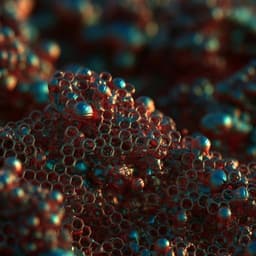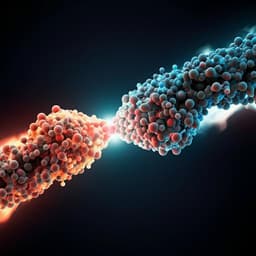
Engineering and Technology
Corrosion resistant and high-strength dual-phase Mg-Li-Al-Zn alloy by friction stir processing
Z. Zeng, M. Zhou, et al.
This groundbreaking research by Zhuoran Zeng and colleagues reveals how friction stir processing followed by liquid CO2 quenching significantly enhances the durability of a dual-phase Mg-Li-Al alloy. The alloy shows remarkable electrochemical degradation resistance and high specific strength, paving the way for more robust applications in lightweight materials.
~3 min • Beginner • English
Introduction
The study addresses the long-standing challenges of poor corrosion resistance and mechanical instability in dual-phase Mg-Li alloys. While adding Li to Mg improves formability and reduces density by introducing a BCC β phase, Mg-Li alloys typically exhibit low strength due to the soft β phase and suffer rapid corrosion via microgalvanic coupling between α and β phases. Prior attempts to strengthen Mg-Li-Al alloys via quenching can raise strength markedly but often result in brittleness and rapid natural age-softening as metastable precipitates coarsen and transform into soft equilibrium AlLi at room temperature. The research aims to engineer a dual-phase Mg-9Li-4Al-1Zn alloy (LAZ941) with simultaneous high corrosion resistance and stable high strength at room temperature by controlling microstructure through friction stir processing (FSP) immediately followed by rapid liquid CO2 quenching.
Literature Review
Background literature indicates: (1) Mg alloys are valued for low density and specific strength but suffer from poor formability and corrosion. (2) Adding >~5 wt.% Li introduces a ductile BCC β phase, improving formability and reducing density (down to ~1.3 g/cm3) with room-temperature elongation >50% for β-containing Mg-Li alloys. (3) Historical development includes NASA’s LA141 and Soviet MA-series alloys. (4) Strengthening Mg-Li-Al alloys via quenching has been attributed to supersaturated solid solutions and precipitates (e.g., MgAlLi2 θ, Al-rich zones, and Mg3Al D03), achieving very high specific strength but often with severely reduced ductility in fully BCC compositions. Mixed α+β alloys regain ductility but suffer from rapid corrosion, with β phase more active than α leading to severe microgalvanic corrosion and mass loss several times that of AZ31 in marine atmospheres. (5) Natural age-softening occurs in quenched Mg-Li-Al alloys as metastable precipitates coarsen and transform to equilibrium AlLi even at room temperature, causing significant loss of strength and hardness over months. Prior corrosion-resistant Mg alloys include BCC Mg-Li and Mg-Zn-Ge systems; however, high corrosion resistance in dual-phase Mg-Li-Al has remained elusive.
Methodology
Materials: Hot-rolled Mg-9Li-4Al-1Zn wt.% (LAZ941) plates (200 mm × 70 mm × 2.5 mm). Benchmark Mg-9Li-1Zn (LZ91) plates were also used. Friction stir processing (FSP): Performed with a cemented WC tool (shoulder 15 mm, probe 6 mm diameter, 2.4 mm length) traveling parallel to rolling direction, rotation speed 600 rpm. Immediately after FSP, rapid cooling by liquid CO2 (−78.5 °C) was applied to suppress grain coarsening; setup per Supplementary Fig. 16. Cooling rates: liquid CO2 quench cools 360 to 100 °C in 0.6 s; water quench ~1.4 s; air cooling ~1.7 °C/s. Water-quenched (WQ) and air-cooled FSP conditions were used for comparison.
Mechanical testing: Dog-bone tensile specimens (gauge length 5 mm, parallel to tool travel) were EDM-cut (Sodick AG360L). Tests on an Instron 4505 at 0.3 mm/min. Three samples per condition. Hardness monitored during natural ageing up to ~2 years.
Electrochemical and immersion testing: Three-electrode flat cell (K-0235), SCE reference, Pt mesh counter, 0.1 M NaCl (200 ml). Specimens mounted in epoxy, ground to 2000 grit under ethanol. OCP stabilized 1 h. Potentiodynamic polarization ±0.3 V vs OCP, 1 mV/s; corrosion parameters by Tafel fitting (EC-lab 11.27). EIS: 100 kHz to 10 mHz, 10 mV amplitude; spectra fit in EC-lab. Immersion tests in 0.1 M NaCl for 20 and 48 h at 23 °C; samples ground to 4000 grit, mirror polished, weighed to 0.01 mg accuracy; hydrogen collection via inverted funnel and burette; corrosion products removed in 20% CrO3 for 15 s; morphology by SEM; optical profilometry (Veeco Wyko NT1100, VSI) on three 1.2 mm × 0.9 mm zones per sample.
Microstructural and surface characterization: SEM (FEI Quanta 3D FEG; Zeiss Ultra-Plus); TEM (FEI Tecnai F20 FEG; FEI Titan3 80-300), atomic-resolution STEM (double-corrected FEI Titan3 80-300, 300 kV, 40 mrad inner semi-angle, 15 mrad convergence, ~0.12 nm probe). TEM disc prep: 3 mm discs, ground to 50 µm, ion-polished (4.8 kV, 4°, −100 °C). FIB lift-out cross-sections after 48 h immersion prepared on Zeiss Crossbeam; Pt protection, Ga ion milling, final thickness ~100 nm; examined on JEOL 2100 for TEM/STEM-EDS.
XRD and GIXRD: Bruker D8 Advance (Cu-Kα, 40 kV, 40 mA), 2θ = 20–80°, 0.01° step; in situ heating/cooling under N2. Calibration with LaB6. GIXRD (incident 0.6°) on PANalytical X’Pert PRO MRD (Cu-Kα, 45 kV, 40 mA).
XPS: Thermo Scientific Nexsa, Al Kα (1486.6 eV), 72 W, spot 400 × 800 µm2; survey 150 eV/1.0 eV step; high-res 50 eV/0.1 eV step; base pressure <5×10−9 mbar; dual-beam charge compensation; depth profiling with Ar cluster ions at 4000 eV. Data processed in Avantage 5.9921, referenced to C1s 284.8 eV.
Key Findings
- Electrochemical durability: After 48 h in 0.1 M NaCl, FSP (liquid CO2 quenched) samples showed hydrogen evolution ~0.1 ml cm−2 day−1 and mass loss 0.72 mg cm−2 day−1, much lower than as-rolled (0.55 ml cm−2 day−1; 1.86 mg cm−2 day−1). Polarization: corrosion current density i_corr ≈ 2.8 µA cm−2 for FSP vs ~32 µA cm−2 for as-rolled. OCP was more noble in FSP samples; EIS showed reduced dissolution kinetics versus as-rolled.
- Durability after ageing: FSP-aged (natural ageing ~2 years) retained low anodic kinetics (stabilizing at 1.6–1.8 µA cm−2) and decreasing dissolution kinetics over immersion by EIS due to protective film evolution.
- Comparative performance: Mass-loss rate and i_corr for FSP-LAZ941 were lower than many reported Mg alloys, including BCC Mg-Li and Mg-Zn-Ge alloys; values were better than pure Mg benchmarks.
- Corrosion morphology: FSP-aged surfaces remained uniform and intact after 48 h immersion with surface roughness within ±1 µm; as-rolled showed localized corrosion with penetration >100 µm. EDXS indicated uniform O distribution on FSP-aged surfaces; as-rolled showed oxygen localized at corrosion sites.
- Protective surface layer: STEM-EDXS revealed a 500–1000 nm oxygen-rich layer containing Mg(OH)2 flakes, underlain by a thin (~50 nm), dense Al-rich layer. SAD indicated MgO and Al2O3. XPS showed higher surface Al atomic percent in FSP-aged (5.3%) vs as-rolled (2.4%). GIXRD detected Al(OH)3 in FSP but not as-rolled.
- Mechanical properties: WQ-LAZ941 yield strength (YS) 260 MPa with ~4% ductility; FSP-LAZ941 YS 308 MPa with 16.5% ductility. High and stable hardness for FSP: from 109 to 98 HV within 3 months, then marginal change (<15% decrease over ~2 years). WQ sample softened rapidly (−>40% hardness in 3 months). FSP YS after natural ageing: 303 MPa (1 week), 274 MPa (3 months), 268 MPa (12 months). Air-cooled FSP (no CO2 quench) had YS 193 MPa and 35% ductility. Specific yield strength for as-FSP and FSP-aged: 182–209 kN·m·kg−1.
- Microstructure: FSP refined grain size to ~2.3 ± 0.8 µm; dense coherent nano-precipitates (~5 nm) in β phase consistent with θ (L21-ordered) structure (a ≈ 6.72 Å). Upon ageing (3 months to 2 years), θ precipitates coarsened to plate-like 100–200 nm length, ~10 nm thick, remained as θ without transforming to equilibrium AlLi; AlLi particles were absent after 2 years in FSP samples. In contrast, as-rolled had abundant AlLi particles (~0.41 µm), which dissolved on heating and re-appeared after ageing in WQ samples. XRD: WQ showed θ peak initially and AlLi after 1 year; FSP showed neither θ nor AlLi in as-FSP state, and θ only after ageing up to 2 years; Mg3Al (D03) peak was not observed.
- Mechanistic comparisons: FSP plus CO2 quench, not FSP alone, was critical to corrosion resistance; air-cooled FSP and Al-free LZ91-FSP did not show comparable corrosion resistance. LZ91 i_corr remained high (as-rolled 95 µA cm−2; FSP 40 µA cm−2).
Discussion
Linking findings to the research aim, the combination of FSP with rapid liquid CO2 quenching engineered a microstructure of uniformly refined grains and a high density of coherent nano-precipitates that provides both high strength and corrosion resistance with long-term stability at room temperature. Rapid quenching from elevated FSP temperatures dissolves harmful AlLi particles and promotes clustering/ordering of Al into coherent θ nano-precipitates, while refined grains and abundant α/β and grain boundaries sequester Al and retard coarsening and transformation to equilibrium AlLi, mitigating natural age-softening. Mechanical strengthening arises from grain refinement and the resistance to dislocation motion by coherent nano-precipitates, maintaining high strength over two years.
Electrochemically, suppressing AlLi formation removes an anode that otherwise drives microgalvanic localized corrosion in dual-phase Mg-Li alloys. Moreover, the FSP/CO2 process promotes formation of an Al-rich protective surface layer (Al2O3/Al(OH)3 with MgO/Mg(OH)2), observed by STEM, XPS, and GIXRD, which enhances passivity across both α and β phases and reduces dissolution kinetics. Comparative tests with Al-free LZ91 and with air-cooled FSP show that Al solute participation and rapid quenching are essential for the protective film and corrosion resistance rather than grain refinement alone. Thus, microstructural control through thermomechanical processing and quench rate addresses both the corrosion and age-softening limitations historically associated with dual-phase Mg-Li-Al alloys, achieving a rare synergy of high strength and ductility with long-term stability.
Conclusion
The study demonstrates that an Mg-9Li-4Al-1Zn (LAZ941) alloy can achieve exceptional electrochemical and mechanical durability via friction stir processing followed by rapid liquid CO2 quenching. The resulting microstructure—fine (~2 µm) grains with dense coherent θ nano-precipitates—suppresses equilibrium AlLi formation, stabilizes strength over years at room temperature, and promotes an Al-rich protective surface layer that yields very low corrosion rates. This processing strategy offers a route to lightweight, durable Mg-Li-Al-based alloys and may be extended to other alloy systems where controlling precipitate state and surface film chemistry is critical. Future work could explore parameter optimization for quench rate, applicability across compositions, and performance under varied environments and service conditions.
Limitations
- The investigation focuses on a specific composition (Mg-9Li-4Al-1Zn) and select processing parameters; generalizability to other Mg-Li(-Al-Zn) compositions or industrial geometries remains to be validated.
- Corrosion testing was conducted in laboratory 0.1 M NaCl solutions and immersion durations up to 48 h; long-term field exposures, varied electrolytes, temperatures, and cyclic environments were not reported.
- Mechanical durability was assessed under quasi-static tension and hardness during natural ageing; performance under fatigue, impact, elevated temperature, or complex loading was not addressed.
- The protective surface film chemistry was inferred from ex situ techniques; in situ/operando characterization of film evolution could further resolve mechanisms.
Related Publications
Explore these studies to deepen your understanding of the subject.







